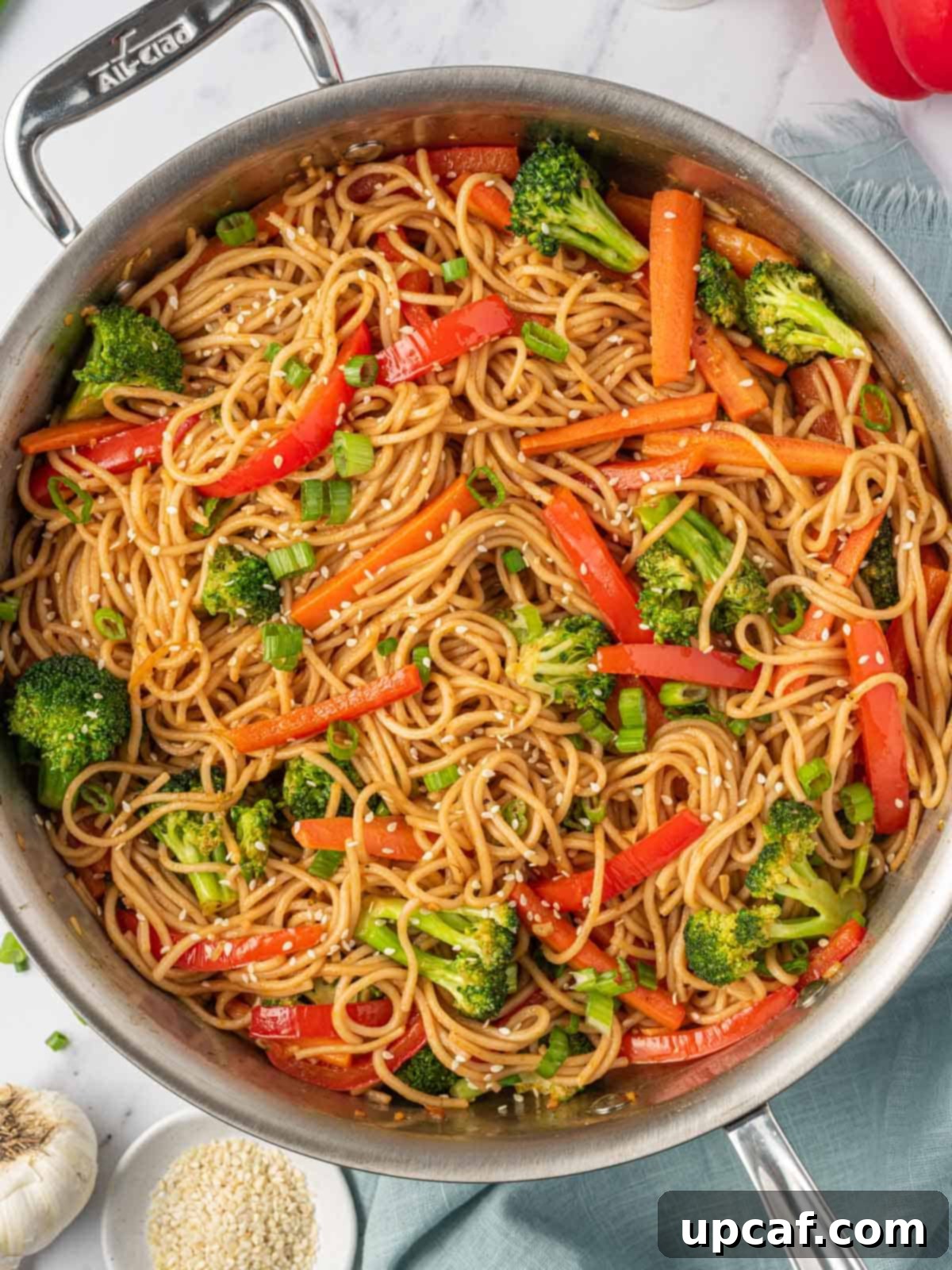Welcome to the ultimate guide to crafting the most authentic and flavorful Vegetable Lo Mein Noodles right in your own kitchen! This recipe is deeply rooted in the traditional Chinese street food experience, bringing a taste of vibrant Asian culinary heritage directly to your dining table. Forget takeout; once you master this homemade version, you’ll never look back. Imagine tender lo mein noodles perfectly stir-fried with a colorful medley of crisp vegetables, all generously coated in a sweet, savory, and slightly spicy umami sauce that dances on your palate. We’re talking about crunchy broccoli florets, sweet julienned carrots, vibrant bell peppers, and fragrant onions, all cooked to perfection. It’s not just a meal; it’s an experience – a symphony of textures and flavors that promises pure comfort in every single bite.
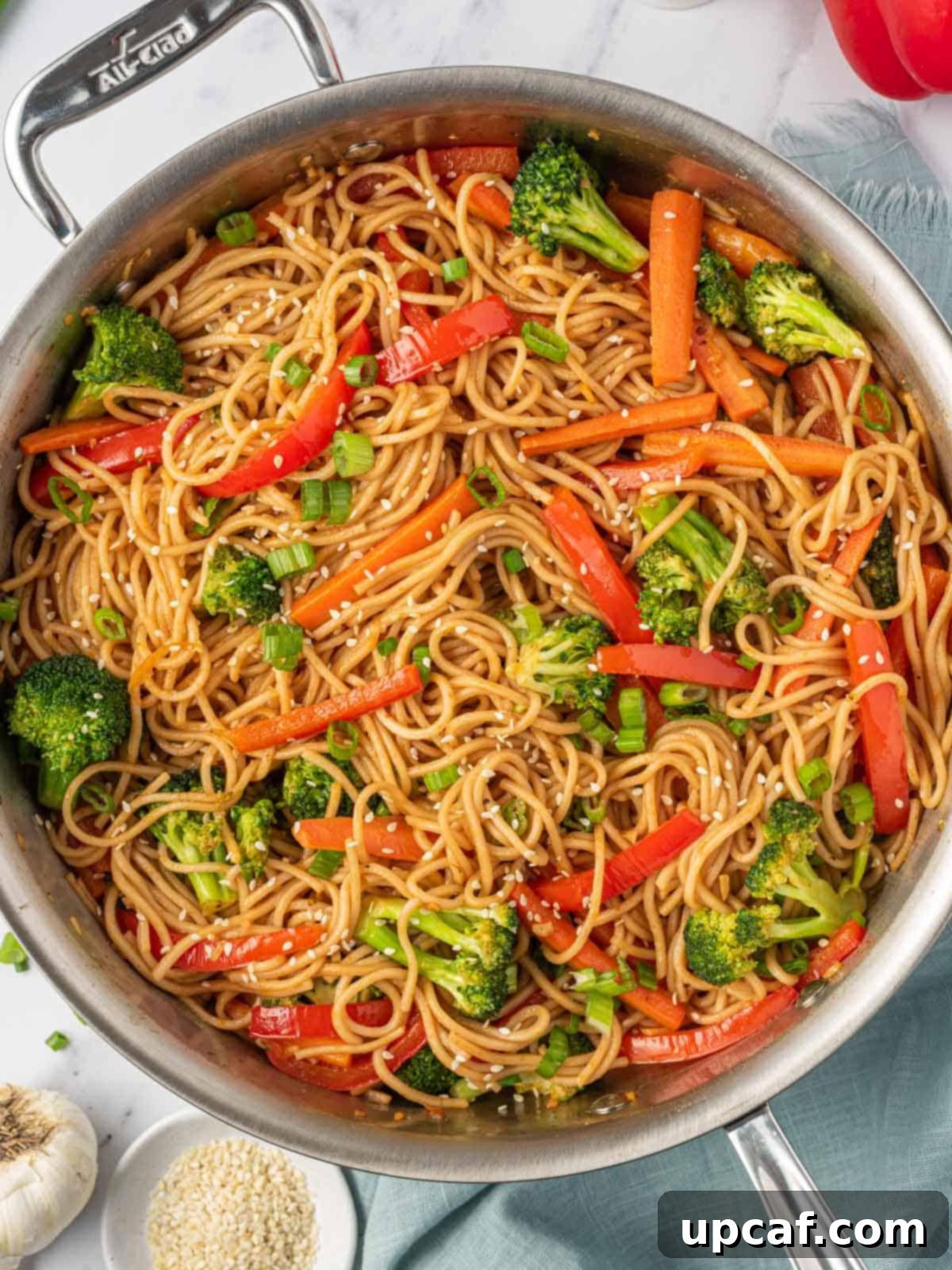
While this veggie lo mein recipe is a dream for vegetarians and vegans alike, its irresistible appeal extends to everyone. It’s an ideal choice for a light yet satisfying lunch, a quick and wholesome weeknight dinner, or even a delightful way to encourage picky eaters, especially kids, to enjoy their vegetables without a fuss. The best part? This mouthwatering dish of vegetarian lo mein noodles can be on your table, ready to be devoured, in an impressive 25 minutes or less. That means less time in the kitchen and more happy moments with a family whose bellies are full of delicious, nutritious food. Prepare to elevate your home cooking with this incredibly simple, fast, and flavor-packed dish that’s guaranteed to become a family favorite.
If you’re a fan of the rich and diverse flavors of Asian cuisine, or if you simply enjoy exploring new and exciting recipes, be sure to explore some of our other popular creations. You might love our Crispy Honey Sesame Chicken, a delightful blend of sweet and savory, or perhaps the zesty kick of Spicy Salmon Crispy Rice. For those who enjoy Indian-inspired flavors, our creamy Paneer Pasanda offers a truly authentic experience.
Why You’ll Absolutely Love This Authentic Vegetable Lo Mein Recipe
There are countless reasons why this homemade Vegetable Lo Mein recipe deserves a permanent spot in your culinary repertoire. It’s more than just a meal; it’s a convenient, healthy, and incredibly satisfying option for any day of the week.
- Effortlessly Customizable for Your Taste: One of the standout features of this veggie lo mein is its incredible versatility. Don’t have broccoli on hand? No problem! This recipe is your perfect canvas for creativity. Feel free to swap in your favorite vegetables or simply use whatever fresh produce you have lingering in your refrigerator. It’s an excellent way to minimize food waste and experiment with different flavor combinations, ensuring every batch is unique and perfectly suited to your preferences.
- A Sauce That Steals the Show: The heart and soul of any great lo mein dish lie in its sauce, and ours is truly unparalleled. This carefully crafted blend of classic Asian ingredients — the rich umami of soy sauce, the subtle sweetness of brown sugar, the pungent warmth of fresh ginger, a hint of heat from sriracha, and the distinct nuttiness of sesame oil — creates a deeply satisfying flavor profile. It’s a sauce that balances sweet, salty, spicy, and savory notes, promising an explosion of flavor that will excite every single one of your taste buds.
- Incredibly Quick and Convenient: In today’s fast-paced world, getting a delicious and healthy dinner on the table quickly is often a top priority. This authentic vegetable lo mein recipe excels in this regard, requiring just 25 minutes from start to finish. This makes it an ideal choice for busy weeknights, last-minute cravings, or when you simply want a home-cooked meal without spending hours in the kitchen.
- Healthy and Nutritious: Packed with a generous array of fresh vegetables and hearty noodles, this lo mein offers a balanced meal that’s rich in vitamins, minerals, and fiber. It’s a fantastic way to boost your daily vegetable intake in a truly delicious format.
- Family-Friendly Appeal: With its vibrant colors and appealing flavors, this vegetarian lo mein is often a hit with the entire family, even the pickiest eaters. It’s an excellent gateway for children to explore Asian flavors and enjoy their greens without complaint.
Essential Ingredients for Easy Lo Mein Noodles
Crafting the perfect Vegetable Lo Mein begins with selecting fresh, quality ingredients. Our recipe divides these into two main categories: the irresistible lo mein sauce and the vibrant stir-fry components. Here’s a detailed look at what you’ll need to create this culinary masterpiece.
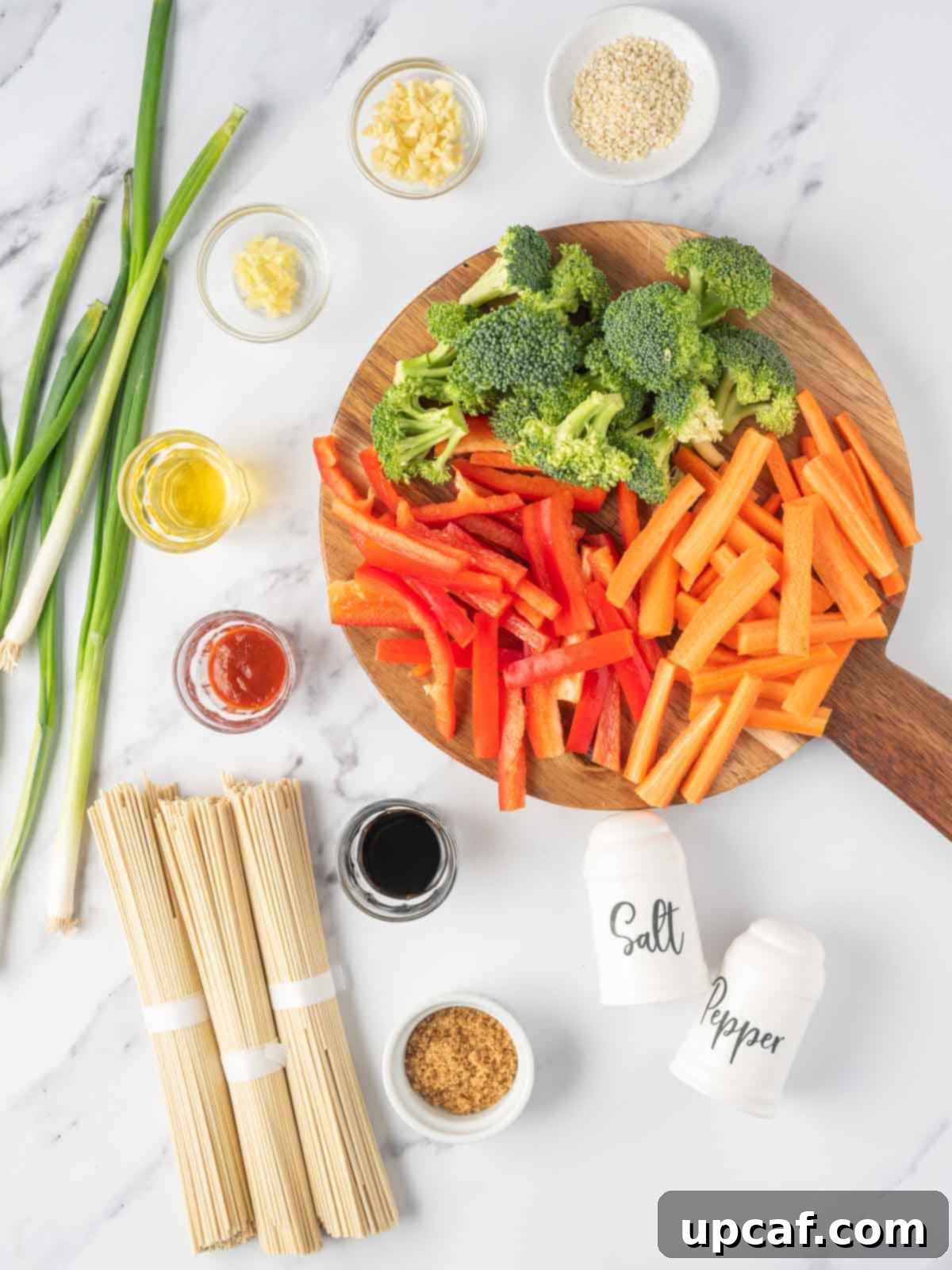
The Irresistible Lo Mein Sauce
This savory and slightly sweet sauce is what brings all the flavors together, coating every noodle and vegetable with a rich, umami-packed goodness.
- Soy Sauce: The foundation of our sauce, providing essential saltiness and umami. We highly recommend using low sodium soy sauce. This allows you greater control over the overall saltiness of your dish, letting the other flavors truly shine without being overwhelmed. For those with gluten sensitivities or dietary preferences, tamari or coconut aminos are excellent gluten-free substitutes that maintain a similar flavor profile.
- Brown Sugar: A touch of brown sugar is crucial for balancing the savory elements of the soy sauce, adding a delicate sweetness and a hint of molasses flavor that enhances the overall depth. If you prefer, you can substitute with other sweeteners like maple syrup or agave, adjusting to your desired sweetness level.
- Fresh Ginger: Finely chopped fresh ginger infuses the sauce with a bright, aromatic, and slightly peppery zest. It’s a key ingredient that provides that distinctive Asian warmth and freshness. Don’t skip the fresh ginger for the best results!
- Sriracha: For those who appreciate a kick of heat, sriracha is your go-to. This popular chili sauce adds a vibrant spiciness that beautifully complements the other flavors. Feel free to adjust the amount of sriracha according to your personal preference for mild, medium, or extra spicy lo mein. If you prefer no heat, you can omit it.
- Sesame Oil: A drizzle of toasted sesame oil is essential for its distinctive warm, nutty aroma and rich, traditional Asian flavor. It provides an earthy depth that rounds out the sauce and adds an authentic touch. A little goes a long way, so use it sparingly for maximum impact.
The Star Lo Mein Ingredients
These components form the bulk of your dish, providing texture, freshness, and substance.
- Lo Mein Noodles: The namesake of the dish! These thick, chewy, wheat-based noodles are traditionally used for lo mein. You can typically find fresh or dried lo mein noodles in the Asian section of most major grocery stores. If fresh lo mein noodles are unavailable, dried ones work wonderfully. For excellent substitution ideas, including gluten-free options, please refer to our Frequently Asked Questions section below.
- Vegetable Oil: Essential for high-heat stir-frying, a light-flavored oil like vegetable oil, canola oil, or grapeseed oil is perfect. These oils have a high smoke point, which is crucial for achieving that authentic stir-fry char on your vegetables without burning.
- Fresh Garlic: Minced fresh garlic adds a warm, pungent, and incredibly aromatic flavor to the stir-fried vegetables. It’s a fundamental flavor builder in Asian cuisine and truly elevates the dish.
- Assorted Vegetables: While broccoli florets, julienned carrots, and thinly sliced bell peppers (red, yellow, or orange) are classic and highly recommended choices for their color, crunch, and nutritional value, the beauty of this recipe lies in its adaptability. This is where you can truly make the dish your own! Other fantastic additions include snow peas, mushrooms (shiitake or cremini), shredded cabbage, snap peas, green beans, asparagus, edamame, baby corn, or water chestnuts. Choose fresh, seasonal vegetables for the best flavor and texture.
- Seasoning: A simple pinch of salt and freshly ground black pepper is all you need to enhance and bring out the natural, vibrant flavors of the vegetables. Seasoning at the right stage ensures everything tastes its best.
- Sesame Seeds: Sprinkled generously as a garnish, toasted sesame seeds add a delightful nutty crunch and a beautiful visual appeal to the finished dish. They provide an extra layer of texture that is highly satisfying.
- Green Onions: Thinly sliced green onions (scallions) are primarily used as a fresh, crisp, and slightly pungent garnish. They add a pop of color and a mild oniony bite that brightens the entire dish upon serving.
How To Create Delicious Vegetarian Lo Mein Noodles
Preparing this authentic Vegetarian Lo Mein is straightforward and incredibly rewarding. Follow these simple steps to bring this vibrant dish to life in your kitchen.
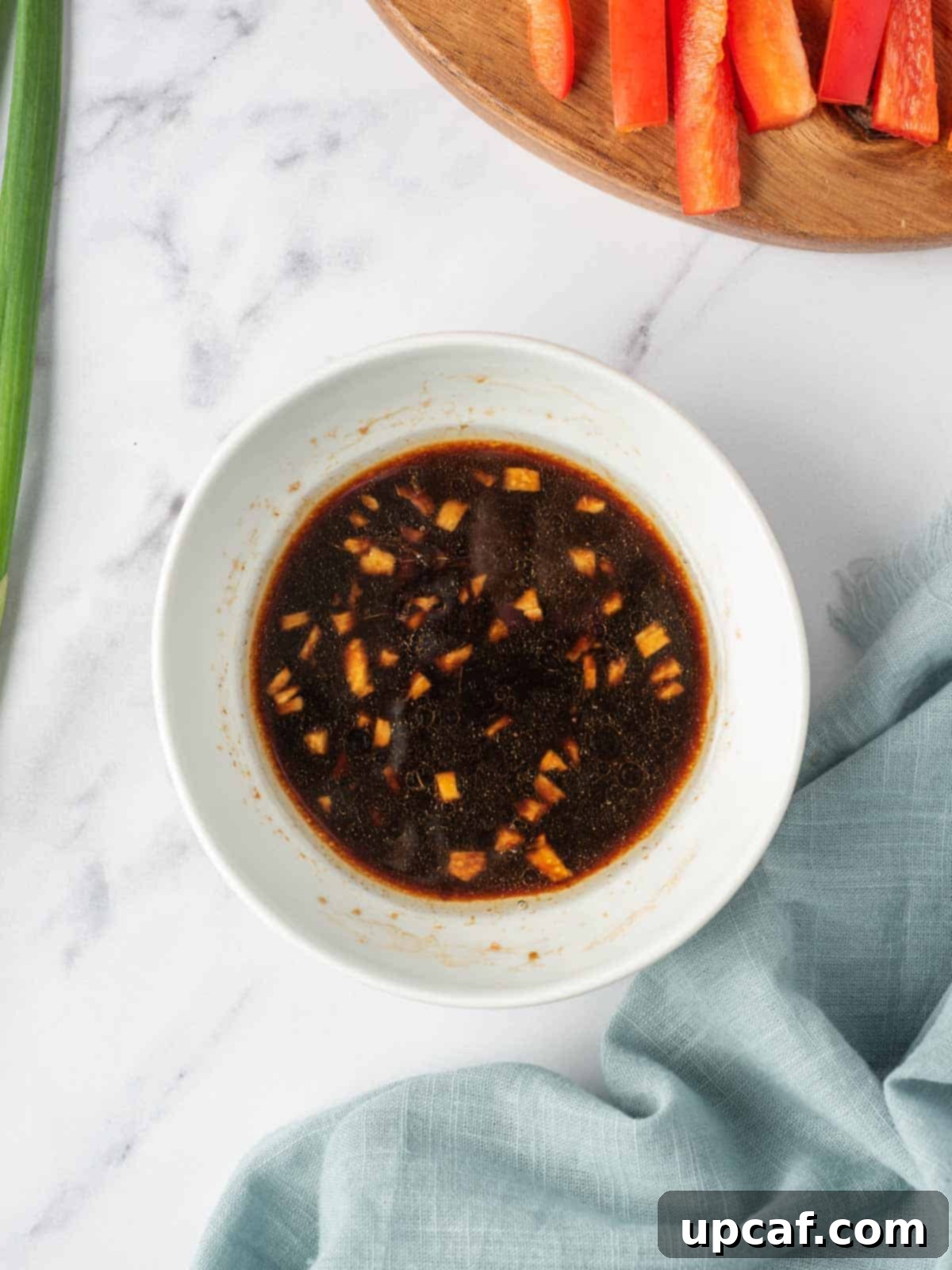
- Step 1: Prepare the Flavorful Sauce. In a small mixing bowl, combine all the ingredients for the lo mein sauce: soy sauce, brown sugar, finely chopped fresh ginger, sriracha (if using), and sesame oil. Whisk everything together thoroughly until the brown sugar has fully dissolved and all ingredients are well incorporated. Set this incredibly aromatic sauce aside; it will be ready to transform your noodles and vegetables.
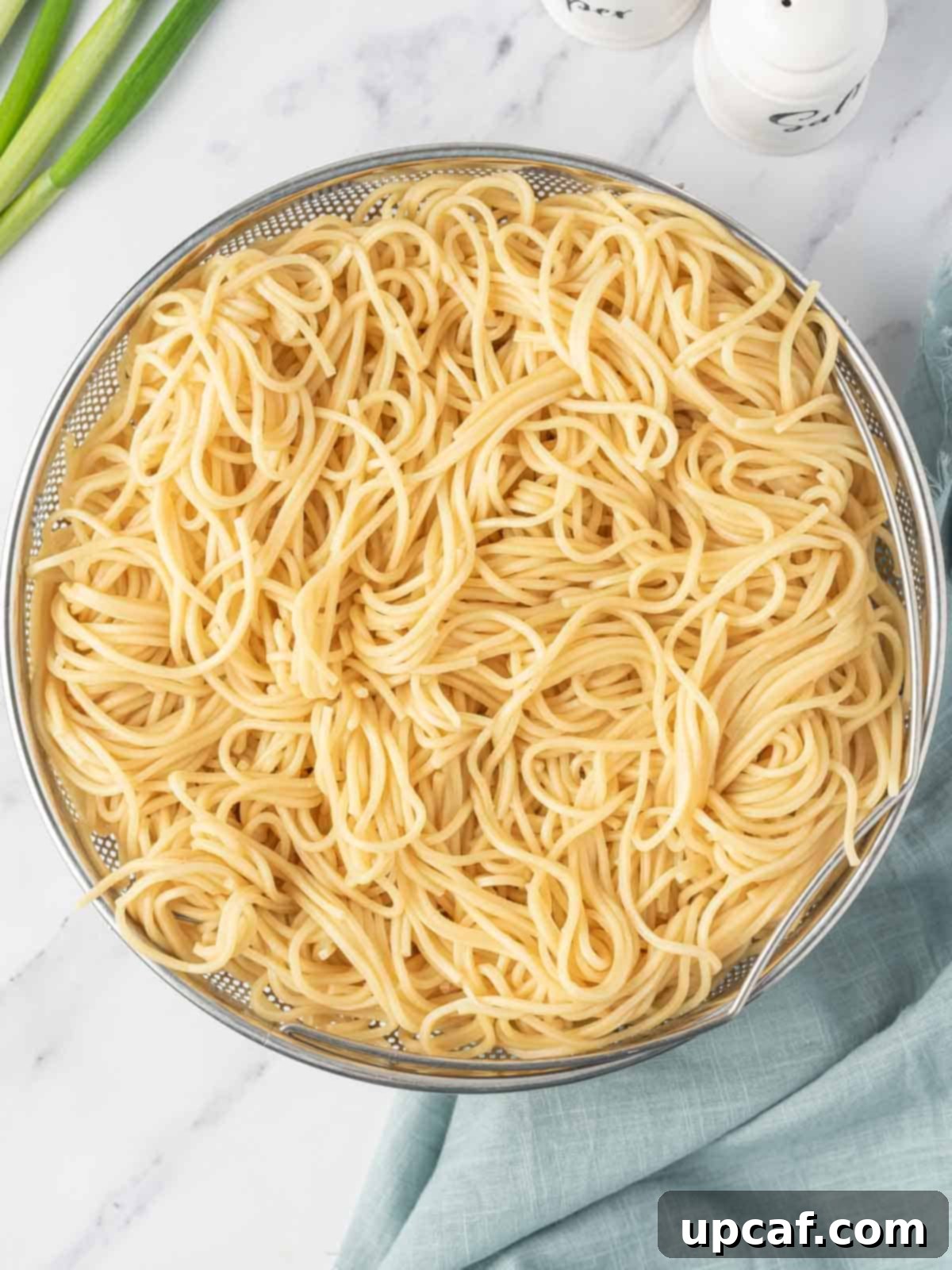
- Step 2: Cook the Lo Mein Noodles. Bring a large pot of water to a rolling boil. Add your lo mein noodles and cook them precisely according to the package instructions. It’s crucial not to overcook them; aim for al dente, where they are tender yet still have a slight bite. Once cooked, drain the noodles immediately and rinse them under cold water to prevent sticking and stop the cooking process. You can toss them with a tiny bit of oil to ensure they remain loose, then set them aside.
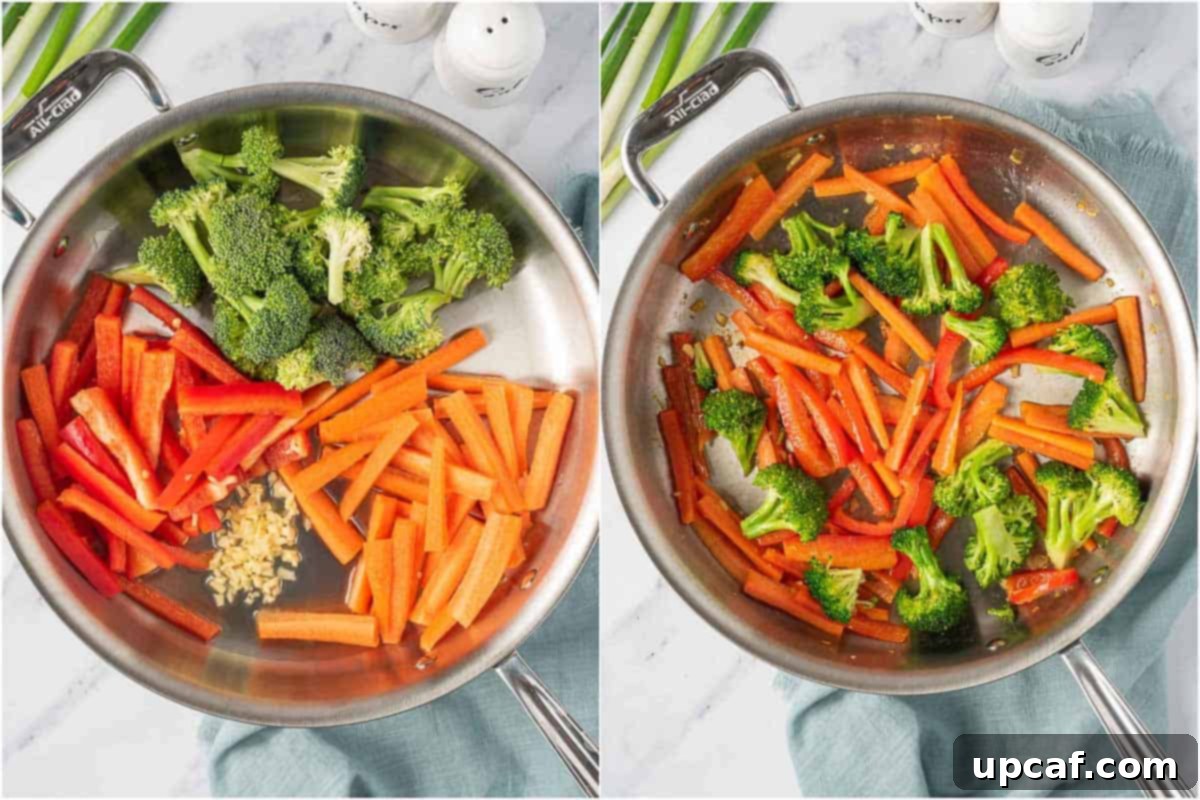
- Step 3: Sauté the Vibrant Vegetables. Heat the vegetable oil in a large skillet or wok over medium-high heat. Once the oil is shimmering, add the minced garlic, broccoli florets, julienned carrots, and thinly sliced bell peppers. Stir-fry the vegetables for approximately 3-5 minutes. The goal is to cook them until they are crisp-tender, retaining a slight crunch and their vibrant colors, rather than becoming soft or mushy.
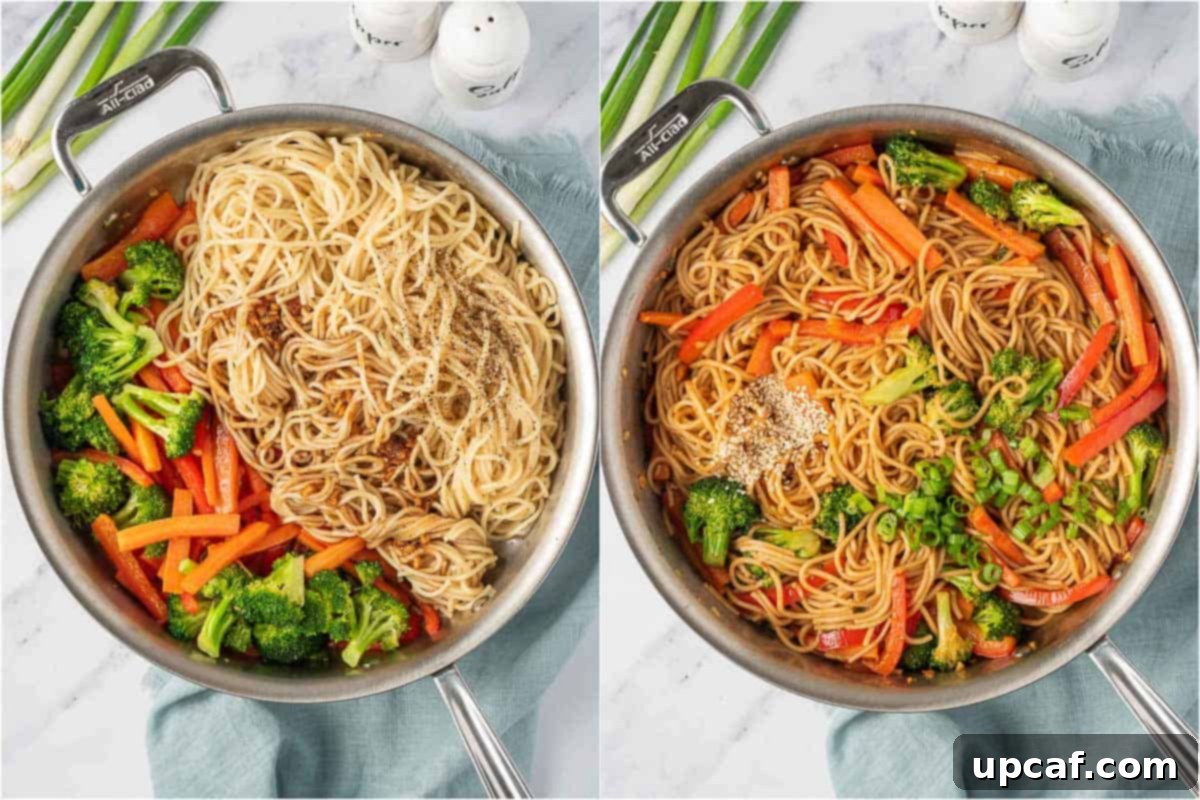
- Step 4: Combine and Toss the Noodles. Reduce the heat to medium. Add the cooked and drained lo mein noodles to the skillet with the sautéed vegetables. Pour the prepared lo mein sauce evenly over the noodles and veggies. Sprinkle in the salt and ground pepper. Using two wooden spoons or tongs, gently but thoroughly toss all the ingredients together for 2-3 minutes, ensuring every noodle strand and piece of vegetable is beautifully coated with the savory sauce.
- Step 5: Garnish and Serve Immediately. Once everything is well combined and heated through, transfer the veggie lo mein into serving bowls. Garnish generously with toasted sesame seeds and freshly chopped green onions. Serve your delicious homemade vegetable lo mein immediately while it’s still warm, allowing the fresh flavors and aromas to be enjoyed at their best.

Expert Tips for Crafting the Best Veggie Lo Mein
Achieving restaurant-quality Vegetable Lo Mein at home is easier than you think with a few key techniques. These tips will help ensure your noodles are perfect, your vegetables are crisp, and your sauce is full of flavor:
- Prep Ahead for Success: Before you even turn on the stove, ensure all your ingredients are prepped and ready. This includes chopping all vegetables, mincing garlic and ginger, and having your sauce mixed. This “mise en place” approach is vital for stir-frying, as the cooking process is very fast.
- Perfectly Cooked Noodles: Always cook your lo mein noodles according to the package directions until they are al dente. This means they should be tender but still slightly firm to the bite. Overcooked noodles will become mushy and won’t hold up well in the stir-fry. Once cooked, drain them and rinse them with cold water to stop the cooking process and prevent them from sticking together. Setting them aside before stir-frying the veggies ensures they’re ready to be added at the right moment.
- Whip Up the Sauce While Noodles Cook: To maximize efficiency, prepare your lo mein sauce in a separate bowl while the noodles are boiling. This allows the flavors to meld slightly and ensures a seamless transition when it’s time to combine everything.
- Customize Your Heat: The sriracha in the sauce provides a lovely kick. If you prefer a milder dish, reduce the amount or omit it entirely. For those who love extra heat, feel free to add a bit more, or even a dash of chili flakes.
- Uniform Vegetable Chops: Ensure all your vegetables are chopped into similar-sized pieces. This consistency is crucial for even cooking, ensuring that every vegetable reaches that perfect crisp-tender texture simultaneously.
- Don’t Overcook Your Veggies: The hallmark of great lo mein is vibrant, crisp-tender vegetables. Stir-fry them quickly over medium-high heat. They should still have a slight bite and bright color, not be soft or faded. Overcooking will diminish their texture and nutritional value.
- Add Garlic Last: When stir-frying vegetables, add the minced garlic towards the end of the sautéing process, usually in the last minute. Garlic burns quickly and can turn bitter if overcooked, so adding it later preserves its aromatic sweetness.
- The Right Tools for Tossing: For easy and thorough mixing, use two wooden spoons or a pair of tongs to toss the noodles, vegetables, and sauce together in the pan. This ensures everything is evenly coated without crushing the noodles or vegetables.
- Don’t Skip the Garnish: The sesame seeds and fresh green onions are not just for aesthetics; they add crucial layers of flavor and texture. Sesame seeds provide a nutty crunch, and green onions offer a fresh, mild oniony bite that brightens the entire dish.
- Serve Immediately: Lo Mein is best enjoyed fresh off the wok or skillet while it’s still warm and the vegetables are at their crisp-tender peak. The flavors are most vibrant right after cooking.

Frequently Asked Questions About Vegetable Lo Mein
Authentic lo mein noodles are typically found in the Asian or international aisle of your local grocery store. They are usually wheat-based and have a slightly thicker, chewier texture than other noodles. If you’re having trouble locating them, a popular and surprisingly effective substitute is spaghetti noodles. While spaghetti and traditional lo mein noodles have different ingredients and textures, cooked al dente, spaghetti can provide a satisfying alternative that will still yield a delicious meal. For those with gluten concerns, gluten-free spaghetti, rice noodles, or even zucchini noodles (for a lighter, low-carb option) can be used instead of wheat-based lo mein noodles.
The beauty of Vegetable Lo Mein is its incredible versatility when it comes to vegetables. While broccoli, carrots, and bell peppers (any color) are classic choices and provide a great balance of flavor, texture, and color, the possibilities are truly endless. Feel free to get creative and use whatever you enjoy or have on hand! Other delicious additions include crisp snow peas, earthy mushrooms (like shiitake or cremini), thinly shredded cabbage, crunchy green beans, delicate asparagus, vibrant edamame, water chestnuts, baby corn, or bok choy. Aim for a variety of colors and textures for a visually appealing and satisfying dish.
While a wok is an excellent tool for stir-frying, offering a large cooking surface and superior heat retention, it is absolutely not essential for making delicious Vegetable Lo Mein. Woks are traditionally designed to be used over very high flames, which most home kitchens aren’t equipped for. A large, sturdy skillet with high sides will perform the job perfectly well. Ensure your skillet is heated properly before adding ingredients and avoid overcrowding the pan to allow for proper stir-frying and to prevent steaming of the vegetables.
Leftover Vegetable Lo Mein Noodles can be stored in an airtight container in the refrigerator for up to 5 days. This makes it a fantastic meal prep option for busy weeks. To reheat, you can use a microwave on medium power, stirring occasionally until warmed through. Alternatively, for best results, reheat it in a skillet over medium-low heat with a tiny splash of water or vegetable broth. Stir-fry gently until the noodles and vegetables are heated evenly and regain some of their texture.
Yes, this veggie lo mein recipe freezes wonderfully! To freeze, allow the cooked lo mein to cool completely, then transfer it to an airtight, freezer-safe container. It can be stored in the freezer for up to 3 months. When you’re ready to enjoy it, thaw overnight in the refrigerator before reheating using the methods described above.
Vegetarian Lo Mein Noodles are truly a complete and satisfying meal on their own, brimming with fresh vegetables and hearty noodles. However, if you’re looking to create a more elaborate feast or simply want to round out the meal even further, it pairs beautifully with a variety of side dishes. Consider serving it alongside Best Grilled Vegetables for an extra boost of greens, our comforting Cheesy Broccoli Bites, or some perfectly Roasted Brussels Sprouts. For a protein boost, add some pan-fried tofu or tempeh.
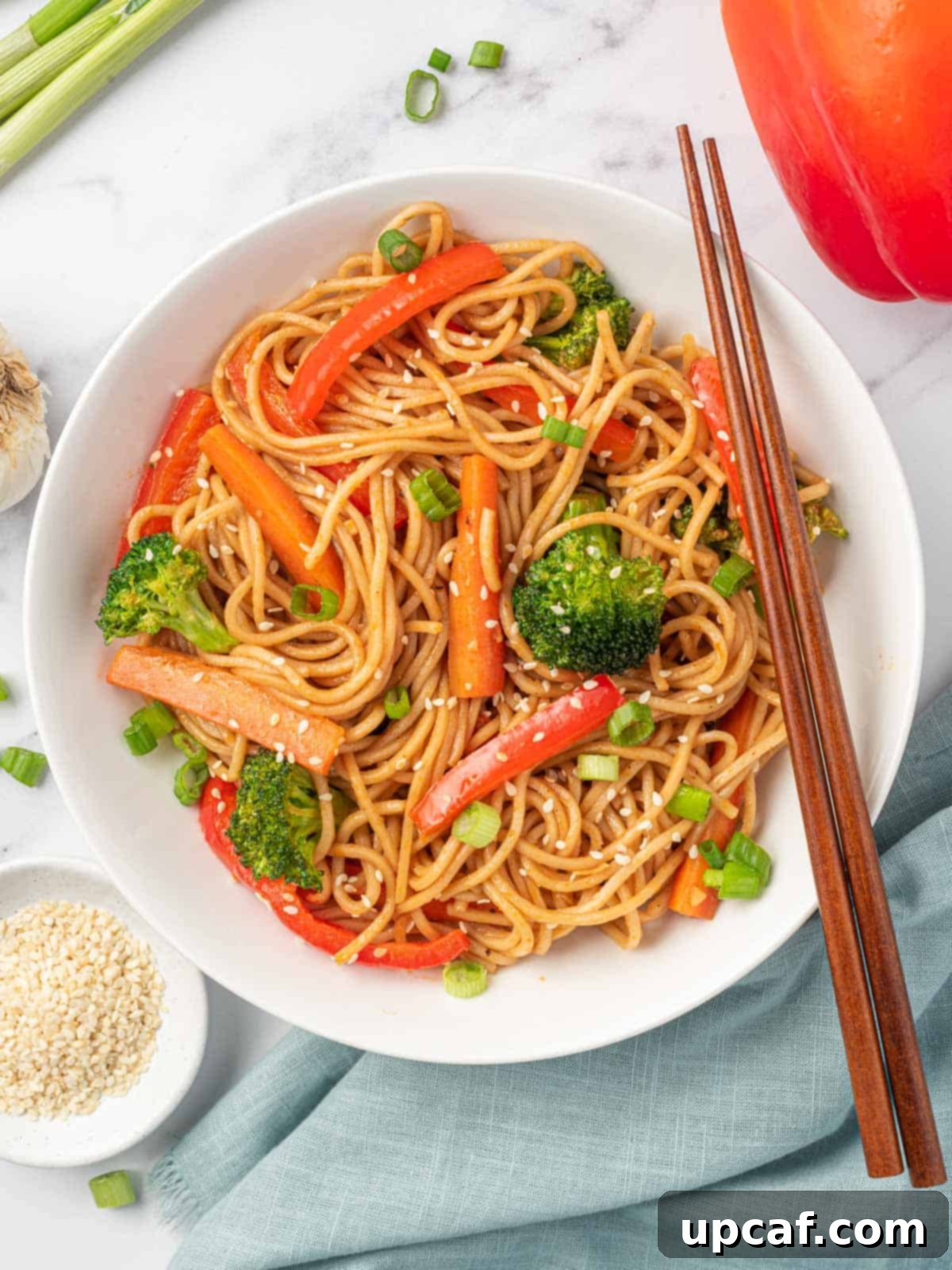
Explore More Delicious Vegetarian Recipes
If you loved this Vegetable Lo Mein, you’re in for a treat! We have a treasure trove of other delightful vegetarian recipes that are sure to inspire your culinary adventures. From comforting pasta dishes to hearty chilies and flavorful dips, there’s something for every craving and occasion. Expand your plant-based cooking repertoire with these fantastic options:
- Baked Eggplant Pasta: A wonderfully satisfying and rich Italian-inspired dish.
- Pasta a la Puttanesca: A quick and bold pasta dish bursting with Mediterranean flavors.
- Easy Vegan Chili: A comforting and hearty classic, perfect for a cozy night in.
- Easy Vegan Lentil Chili: A protein-packed twist on traditional chili, full of flavor.
- Keto Cauliflower Mac and Cheese: A guilt-free, low-carb take on a beloved comfort food.
- Easy Lebanese Hummus: A creamy, authentic dip perfect for snacking or entertaining.
We truly hope you enjoy every recipe we share with you, and this delightful Easy Lo Mein Sauce recipe with noodles is no exception. We encourage you to try it, savor every bite, and share your experience. Your feedback, ratings, and comments are invaluable to us!
If you try this incredible recipe and find yourself loving it as much as we do, please take a moment to leave a star rating and share your thoughts in the comment section below. We adore seeing your culinary creations! Use our hashtag #CookinWithMima to share it with us on Instagram, so we can admire your delicious recreations! Don’t forget to follow Cookin’ With Mima on FACEBOOK | INSTAGRAM | PINTEREST for all our latest recipes, cooking tips, and social updates. Happy cooking!

Vegetable Lo Mein Noodles
Ingredients
For the sauce
- 2 tablespoons soy sauce
- 2 teaspoons brown sugar
- 1 teaspoon ginger, chopped
- 1 teaspoon sriracha
- 1 teaspoon sesame oil
For the lo mein noodles
- 8 oz lo mein noodles
- 1 tablespoon vegetable oil
- 1 teaspoon garlic, minced
- ¾ cup broccoli, cut into florets
- 2 whole carrots, cut into thin strips
- 1 medium red bell pepper, cut into thin strips
- ½ teaspoon salt
- ½ teaspoon ground pepper
- 1 tablespoon sesame seeds
- 2 tablespoons green onions, chopped
Instructions
- In a small bowl, combine the ingredients for the sauce; soy sauce, brown sugar, ginger, sriracha, and sesame oil. Whisk well and set aside.
- Cook the lo mein noodles according to the package instructions until al dente. Drain and rinse with cold water, then set them aside.
- Heat vegetable oil in a large skillet or wok over medium-high heat. Add the broccoli, carrots, and bell peppers. Stir-fry for 3-5 minutes until crisp-tender, then add the minced garlic and stir-fry for 1 minute more.
- Add the cooked noodles to the skillet along with the prepared sauce, salt, and pepper. Toss vigorously for 2-3 minutes, ensuring all ingredients are well combined and coated in the sauce.
- Transfer to serving bowls, sprinkle with sesame seeds and chopped green onions. Serve immediately while warm for the best flavor and texture.
Notes
- Cook the noodles according to the package and set them aside before you stir fry the veggies to ensure efficiency.
- Prepare the sauce while the noodles cook to save time and allow flavors to meld.
- Adjust the amount of sriracha to make the sauce mild or spicy, catering to your preference.
- Chop your veggies into similar size pieces, so they cook evenly and retain their texture.
- Don’t overcook the veggies; they should be crisp-tender for optimal taste and crunch.
- Add the garlic last when stir-frying the vegetables to prevent it from burning and becoming bitter.
- Use two wooden spoons or tongs to toss everything together in the pan for easy and even coating.
- Don’t skip the garnish; sesame seeds and green onions add crucial flavor and visual appeal.
- Serve immediately to enjoy the best texture and freshest flavors of the dish.
Nutrition
Like this recipe? Rate and comment below!
